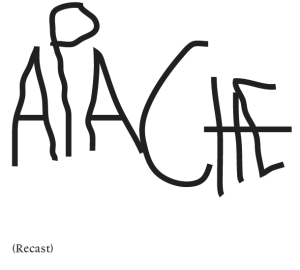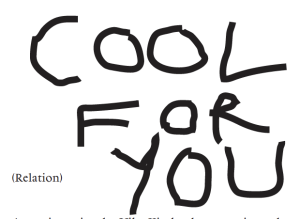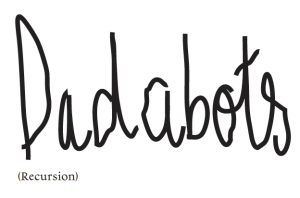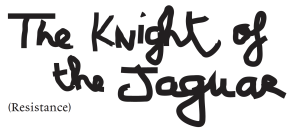P-Prompt: re:re:re:er:ri mixtape
Erri Ammonita share four stories about selected songs copied on 19 used cassette tapes decorated with found letters. The stories printed in a booklet in dialogue with the music on the mixtapes bring up the many layers of reuse that form part of making music. It is a contribution to think along with the CC4r about the ethics and politics of re-use, through music. Each story engages with (and sometimes provides a possible answer to) one of the following questions:
- How to collectively resist appropriation outside legal frameworks?
- What type of reuse is the indiscriminate and automated one brought on by machine-processes? Why and how to take collective stances towards it?
- Can reuse without consent of “original authors” happen in a response-able and critically implicated manner?
- How does something stereotypical, offensive and mercenary get turned into something empowering and radical, and vice versa?
Download booklet re:re:re:er:ri mixtape (PDF)
Both the booklets and mixtapes are in slow hand-to-hand pick-up circulation. If you would like to receive the tape and booklet, do write us an email, and we'll put it in our or a friend's bag, when a trip to your destination is on the schedule.

(Resistance)
A1 The Aztec Mystic - Jaguar (6.38)
A2 Type - Jaguar (Original Covered Version) (6.37)
A3 The Aztec Mystic - Jaguar (Mad Mike Remix)(4.21)
(Recursion)
AA1 Archspire - Involuntary Doppelganger (3.46)
AA2 Dadabots - Relentless Doppelganger (as long as Youtube allows)

(Relation)
B1 COOL FOR YOU - STRATEGICALLY ADAPTABLE (3.17)
B2 COOL FOR YOU - SEEING DIFFICULTIES (1.58)
B3 COOL FOR YOU - SHAME/HUMILIATION (2.08)
B4 COOL FOR YOU - STABILIZED, YES! (2.40)
B5 COOL FOR YOU - SHE WHOSE BLOOD (3.24)
B6 Sacred Harp Convention 1959 - #112 The Last Words of Copernicus (1.41)
B7 Sacred Harp Convention 1959 - #215 New Topia (2.00)
(Recast)
BB1 Bert Weedon - Apache (~0.30)
BB2 The Shadows - Apache (~0.30)
BB3 Jorgen Ingmann - Apache (~0.30)
BB4 The Ventures - Apache (~0.30)
BB5 Davie Allan and the Arrows - Apache (~0.30)
BB6 The Incredible Bongo Band - Apache (~0.60)
BB7 The Adventures Of Grandmaster Flash On The Wheels Of Steel (~0.30)
BB8 West Street Mob - Break Dance - Electric Boogie (~0.30)
BB9 Sugarhill Gang - Apache (~0.30)
BB10 Missy Elliot - We Run This (~0.30)
BB11 TLC - Hat 2 Da Back (~0.30)
BB12 Goldie - Inner City Life (~0.30)
BB13 FSOL - We Have Explosives Remix (~0.30)
BB14 Aphex Twin - Heliosphan (~0.30)
BB15 The Roots - Thought At Work (~0.30)
BB16 Scooter - Apache (~0.30)
BB17 Soundmurderer and SK1 - Call da Police (~0.30)
BB18 Rage Against The Machine - Renegades of Funk (~0.30)
BB19 Amy Winehouse - In My Bed (~0.30)
BB20 Bizzy B - 2099 dub (~0.30)
BB21 Jahba - Bush (~0.30)
BB22 Action bronson - Mofongo (~0.30)
BB23 NAS - Made you look (~0.30)
BB24 Dj Scud & Christoph Fringeli - Something Violent (~0.30)
BB25 Night Tapes - Humans (~0.30)
A song with a layered story, a reminder of how unpredictable paths a song can take when recording supports come in: with empty or problematic backgrounds, (parts of) this song became a source for empowering and meaningful music. The origin of the song «Apache» is not that important, and by the way it kinda sucks: the original song was written in 1960 by Bert Weedon, «inspired» by American Western movies and their caricature of the relations between Native Americans and Settlers. The song is then covered by a band called The Shadows, and has medium success in the UK, and then in Denmark by Jorgen Ingmann, the covers take an «Hawaiian» twist, and the song becomes a hit for the first time. A few other «surf versions» follow but then this cover series dies out. «Apach» reappears in 1972, retaken by The Incredible Bongo Band, formed for writing the soundtrack of the B-movie «The Thing with Two Heads», a blaxploitation-science-fi ction-comedy film. Their cover of the song introduces a long hand percussions and drums solo, making it perfect reuse material during the first emergence of Hip Hop culture in the early 70s. DJs would search for obscure records in crates at record shops, looking for beats you could dance to at block parties. So DJ Kool Herc finds the record of The Incredible Bongo Band, which thanks to its long drum break, he can use in his «Merry-Go- Round technique» that loops drum breaks on two of the same record, endlessly as a background for breakdancing. As DJ’s would usually do back then, he would hide the label of the record at performances to gain a certain exclusivity and create his sound signature.

A song with a layered story, a reminder of how unpredictable paths a song can take when recording supports come in: with empty or problematic backgrounds, (parts of) this song became a source for empowering and meaningful music. The origin of the song «Apache» is not that important, and by the way it kinda sucks: the original song was written in 1960 by Bert Weedon, «inspired» by American Western
movies and their caricature of the relations between Native Americans and Settlers. The song is then covered by a band called The Shadows, and has medium success in the UK, and then in Denmark by Jorgen Ingmann, the covers take an «Hawaiian» twist, and the song becomes a hit for the first time. A few other «surf versions» follow, but then this cover series dies out.
«Apache» reappears in 1972, retaken by The Incredible Bongo Band, formed for writing the soundtrack of the B-movie «The Thing with Two Heads», a blaxploitation-science-fiction-comedy film. Their cover of the song introduces a long hand percussions and drums solo, making it perfect reuse material during the first emergence of Hip Hop culture in the early 70s. DJs would search for obscure records in crates at record shops, looking for beats you could dance to at block partys. So DJ Kool Herc finds the record of The Incredible Bongo Band, which thanks to its long drum break, he can use in his «Merry-Go- Round technique» that loops drum breaks on two of the same record, endlessly as a background for breakdancing. As DJ’s would usually do back then, he would hide the label of the record at performances, to gain a certain exclusivity and create his sound signature. Despite this precautions, this song and its drums and percussions breaks has such a success that it becomes extremely famous in the Hip hop scene, to the point that new tracks are created that are explicitly sampling the song. So it is another «Apache» song that goes mainstream, from the first commercial Hip Hop act : The Sugar Hill Gang. This band is put together by the label Sugar Hill, the first to capitalize on underground Hiphop, and they records a fully messed up version of the song
with more caricatures of Native Americans, and samples from The Incredible Bongo Band.
The song has become a fundamental element in Hip Hop, and with the explosive growth of the movement, companies are making records for early sound producers: they sell breaks records, compiling samples ready to be used. Apache is a must in them. In the 80’s and 90’s with the digitalization of sound, the music industry adapts these products to digital samples packs. By being in most of these sample packs, «Apache» ends up being used by thousands and thousands of music producers, becoming such a classic drums sample that it sort of plays the role of a very discreet musicians’ meme. The fi rst electronic music producers start in the 90’s from the same sample packs, so Breakbeat, Jungle, Drum and Bass, Breakcore, all continued in making the drums break from The Incredible Bongo Band ubiquitous.
In this story the copyright question isn’t really coming in, no courtcases are connected to the massive reuse of this sample, but these opportunistic reuses made it a key element in the social and cultural movement of Hip Hop. There is no one origin of Apache, or there are many, and in any case they are all messy and show how every music project starts already implicated in the modes of capitalist cultural production.

A music project by Vika Kirchenbauer, artist and musician. In her article «Complicating Critique» she shares about her practice, that has been oriented by the idea of «sampling as critique». Her work in COOL FOR YOU takes on a decolonial angle, as she chose to use recordings of the Sacred Harp, a choir practice from the South of the USA that got diff used around the middle of 1800 as part of the colonization process, therefore implicated with slavery and the extermination of American natives. Imported from the British settlers, this choir practice was performed by amateurs, majorly white Christians, that sung exclusively for their community as a form of
social-religious gathering and bonding moment.
Even though she does not mention the source recordings used, Kirchenbauer seem to sample the recordings of ethnomusicologist Alan Lomax, who had access to a Sacred Harp convention in his function of archivist of American folk music in the 50s. Due to the trust accorded to Lomax by the members of this community, he could record a form of music that was not meant to be for a public.
In her article, Vika shares the intellectual and relational placement of her practice, starting with her intention to take the recordings of the Sacred Harp, beyond the consent of the recorded ones, and make new pieces as a way to work on the entanglement of music and colonization. Describing what happened in making this work, she mentions that by getting close with the material, instead of exercising a mode of critique that was detached and distancing from its object, she became more and more entangled with the sources. Reflecting on the way in which critique is implicated with its object, Vika shares how she has been touched by something she wanted to critique in the first place, through the process of sampling and listening to these sounds intimately.
The combination of her sound and writing work is rich and complex, as Kirchenbauer navigates questions of appropriation and copyright and legitimacy in an uncharted manner, through implication and affect.
An EP by DJ Rolando. He’s a member of Underground Resistance, which is a collective and a record label started by black musicians in the end of the 80’s in Detroit. UR is fundamental element in the emergence of the techno scene, producing records and setting up events with DIY means and self-organization. They were seing music as a way to fi ght against the society and its oppression, and were explicitly anti-major labels and against music industry. DJ Rolando, aka The Aztec Mystic, who comes from latino community, enters the collective in the 90’s and releases in 1999 the EP «The Knight of the Jaguar» which contains a track named «Jaguar». The track is very successful in underground techno circles, to the point of receiving attention from the mainstream. Early 2000, Underground Resistance gets informed that Sony BMG (the branch of the firm in Germany), circulates a promo release of a track called «Jaguar», a sound-by-sound commercial ripoff of DJ Rolando’s track, without crediting anybody. UR takes it as a declaration of war, more than a clear case of cultural appropriation. They choose to not go for the legal way for two main reasons. First of all Sony has infi nite fi nancial ressources to handle a legal procedure, but most of all, they don’t believe in the justice services from the government, nor in copyright as a mean to regulate cultural production. So they take it on with DIY means, and selforganize the resistance through their online and offl ine communication channels with the support of the techno community and beyond, calling for diff erent modes of direct actions. In different places in the US and elsewhere, UR supporters pressure local shops not to take on Sony’s release, or directly hide or steal copies in shops, and circulate the story further. Another strategy brought on by UR was releasing the album «The Revenge of the Jaguar», composed by remixes of the original track by UR artists. Using the ongoing hype on the story, they produced the remix record in the UK, to bring to the European market their own versions of the track. After all this, Sony off ers to pay the rights and attributions to the author of the song, which the collective refuses and sticks to their approach, so Sony fi nally cancels the release and buries its shitty version.


